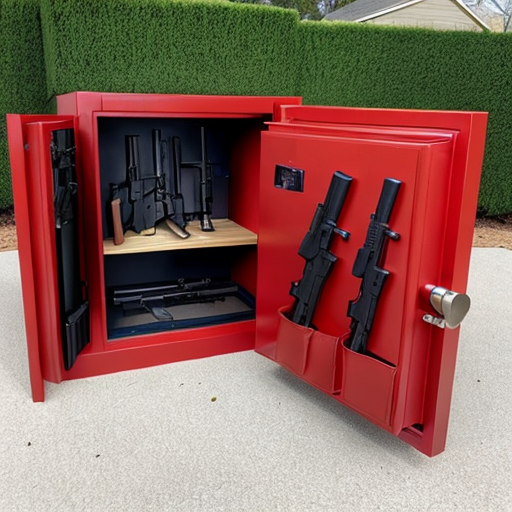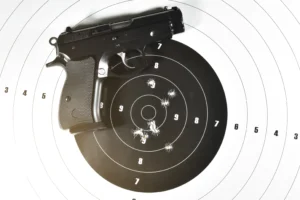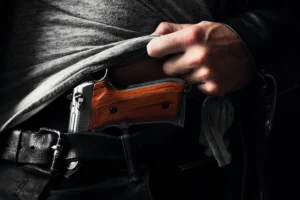Properly storing firearms is of paramount importance to ensure the safety of individuals and prevent unauthorized access. Responsible firearm owners understand the significance of securely storing their firearms to protect their loved ones and prevent accidents or misuse. In this comprehensive article, we will discuss the best practices for firearm storage, focusing on safety, security, and the promotion of responsible ownership.
Choose a Dedicated Storage Solution: Investing in a dedicated storage solution specifically designed for firearms is crucial. There are various options available, including gun safes, lockboxes, and firearm-specific cabinets. These storage solutions offer a secure and controlled environment, safeguarding firearms from unauthorized access and potential damage.
Example: When selecting a gun safe, consider a high-quality option such as the Liberty Fatboy Jr. Gun Safe, which features heavy-duty steel construction, pry-resistant doors, and a secure electronic lock. This safe meets UL ratings for security, providing peace of mind for firearm owners. Its spacious interior allows for the storage of multiple firearms, ammunition, and accessories.
Gun Safes: Opt for Quality and Security Gun safes are widely regarded as the most effective storage solution for firearms. When selecting a gun safe, prioritize features such as robust construction, pry-resistant doors, and secure locking mechanisms.

Where do you store your guns safely?
Look for safes that meet recognized industry standards for security, such as Underwriters Laboratories (UL) ratings. Consider the size of the safe to ensure it can accommodate your firearm collection and any accessories.
Ensure Proper Placement: Select an appropriate location for your gun safe that balances accessibility for authorized individuals while keeping it out of reach for unauthorized users, especially children or potential intruders. Consider placing the safe in a secure room, away from areas frequented by guests or family members who may not be familiar with firearms. Concealment and discretion are key factors to prevent attracting undue attention.
Example: Ensure proper placement of your gun safe by installing it in a dedicated room or area of your home. For example, you may choose to place the safe in a secure basement room with limited access or in a discreet corner of your bedroom. By strategically positioning the safe, you minimize the risk of unauthorized individuals stumbling upon it while maintaining accessibility for authorized users.
Use Additional Security Measures: To enhance the security of firearm storage, utilize additional measures such as cable locks, trigger locks, or lockboxes for ammunition. These additional security measures add an extra layer of protection, ensuring that even if someone gains access to the storage area, they cannot use or access the firearms. Consider employing gun locks for individual firearms within the safe for added security.
Example: To enhance the security of your firearm storage, consider using a cable lock like the Master Lock Cable Gun Lock. This lock securely immobilizes the firearm, preventing it from being loaded or fired. Another option is a trigger lock, such as the GunVault NV200 Nanovault, which blocks access to the trigger, rendering the firearm inoperable. Additionally, utilize lockboxes specifically designed for storing ammunition, like the SnapSafe Lockbox, to ensure separate and secure storage.
Educate Family Members: Education is a fundamental aspect of responsible firearm ownership. Take the time to educate your family members, especially children, about firearm safety. Teach them to respect firearms, understand the potential dangers, and emphasize the importance of never handling firearms without adult supervision. Encourage an open dialogue about firearms, answering questions, and demystifying any misconceptions. By promoting education, you can instill responsible habits and create a safe environment within your household.
Example: Teaching firearm safety to family members is crucial. Use resources like the Eddie Eagle GunSafe Program, which offers age-appropriate materials and interactive content to educate children about firearm safety. Demonstrate safe handling practices, such as keeping fingers off the trigger and pointing the muzzle in a safe direction. Engage in open conversations about firearms, emphasizing responsible behavior and the potential consequences of mishandling them.
Store Ammunition Separately: To further enhance safety, store ammunition separately from firearms. Keep ammunition locked in a separate container or safe, ensuring that unauthorized individuals cannot access both firearms and ammunition simultaneously. This separation reduces the risk of accidents or misuse, especially if someone gains unauthorized access to the firearm storage area.
Example: To store ammunition separately, consider using a secure ammo can such as the Plano Field Locker Ammo Storage Box. This waterproof and lockable container ensures that only authorized individuals have access to the ammunition. By separating ammunition from firearms, you add an extra layer of security and reduce the risk of accidents or misuse.
Regular Maintenance: Maintaining firearms in good working condition is crucial for safe storage. Regularly clean and inspect firearms to prevent malfunctions, ensure proper functioning, and minimize the risk of corrosion. Lubricate moving parts appropriately and address any issues promptly. Regular maintenance not only ensures safety but also extends the lifespan of firearms, preserving their value.
Example: For regular maintenance, invest in a firearm cleaning kit like the Real Avid Gun Boss Pro Universal Cleaning Kit. This comprehensive kit includes brushes, jags, and cleaning rods to properly clean various firearms. Regularly inspect your firearms, paying attention to rust or damage, and address any issues promptly. By maintaining your firearms in good working condition, you ensure their safe storage and optimal performance.
Consider Quick Access Solutions: For self-defense firearms, it is important to balance security with accessibility. Consider quick access solutions that allow for rapid retrieval in emergencies while still maintaining security. Biometric safes, electronic locks, or mechanical lockboxes with combination locks can provide fast and secure access when needed. Ensure that any quick access solution complies with your local regulations and is well-suited to your specific needs.
Example: Consider a quick access solution such as the Vaultek VT20i Biometric Handgun Safe. This safe utilizes biometric fingerprint scanning technology for rapid and secure access to your self-defense firearm. The advanced security features and tamper-proof construction of this safe ensure quick retrieval in critical situations while preventing unauthorized use.
Secure Transport: When transporting firearms, ensure they are unloaded and secured in a locked container or case. This prevents accidental discharge and unauthorized access during transportation. Familiarize yourself with the local laws and regulations regarding firearm transportation to ensure compliance. Utilize dedicated firearm cases or discreet covers that do not draw unnecessary attention while providing adequate protection.
Example: When transporting firearms, use a lockable case like the Plano All Weather Tactical Gun Case. This case provides secure storage and transportation, with foam padding to protect the firearms from damage. Ensure the case is securely locked with a non-obtrusive lock to maintain a low profile during transportation.
Regularly Review Security Measures: Periodically evaluate your storage solutions and security measures to ensure they meet your changing needs. As your firearm collection grows or your circumstances change, you may need to upgrade or modify your storage arrangements. Stay informed about advancements in storage technology and adjust your practices accordingly. This includes staying updated on local laws and regulations regarding firearm storage to ensure compliance.
Example: Let’s say you’ve been storing your firearms in a traditional gun safe for a few years. However, as your firearm collection has grown, you realize that the current safe is becoming crowded and less convenient to access. It’s time to review your security measures and make necessary adjustments.
After researching advancements in storage technology, you come across the Fort Knox PB1 Handgun Safe. This safe offers a more compact and efficient design, with quick and easy access to your handguns. It also features a tamper-proof locking mechanism and exceeds UL ratings for security.
You decide to upgrade your storage arrangement by purchasing the Fort Knox PB1 Handgun Safe and using it to store your frequently accessed handguns. For your long guns and additional firearms, you choose to invest in a larger gun safe that offers enhanced storage capacity and improved organization, such as the Browning ProSteel Gun Safe. During this review process, you also become aware of changes in local laws and regulations regarding firearm storage. You take the time to familiarize yourself with these updates and ensure that your storage arrangements comply with the current requirements.
Engage in Community Discussions and Training: Participating in community discussions and seeking training opportunities can further enhance your knowledge and skills in firearm storage. Attend local workshops or seminars on responsible firearm ownership and storage. Engage with fellow firearm owners to exchange experiences, best practices, and tips for maintaining safe storage. By actively participating in these discussions and seeking continuous education, you contribute to fostering a culture of responsible firearm ownership.
Example: Participate in community discussions through online forums or attend local gun clubs where responsible firearm owners share their experiences and best practices for storage. Take advantage of training opportunities, such as NRA-certified courses, that offer comprehensive education on firearm safety, storage, and responsible ownership. By actively engaging in these discussions and seeking training, you enhance your knowledge and contribute to a culture of responsible firearm storage and ownership.





